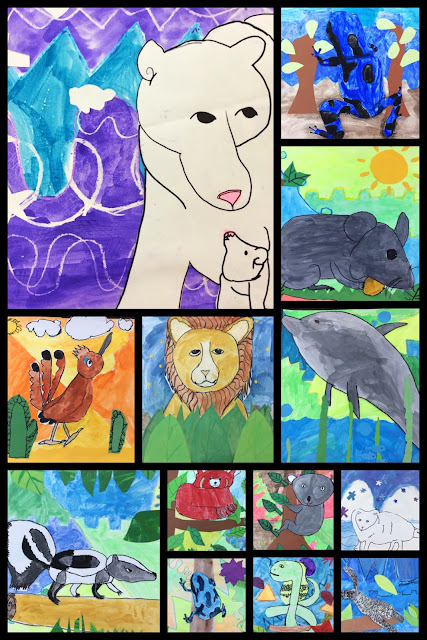All classes are involved with deciding on essential art room agreements. We do this through think, pair, share sessions and keep track of everyone's ideas on large pieces of paper. These ideas are then grouped into categories so we can choose 4-5 simple "art room promises" for everyone to remember. After we have decided on which promises we will go ahead with, each grade is responsible for designing something to personalize our special art room for the year.
Grade 1: Essential Agreements
After taking part in brainstorming and discussing important art promises, grade 1 students jump right in to art room routines in order to practice and remember our agreements while getting used to a new classroom and starting our first unit of the year.
Grade 2: Art Action Wall
Grade 2 students also begin with their unit right away, participating in a variety of fun activities. One of the activities that fits in well with our abstract art unit is a focus on Kandinsky. The students listen to a variety of music and paint with colors, lines, and shapes based on how the music makes them feel. They do this in small groups on large pieces of paper and this used for our art action wall where we celebrate students taking their knowledge outside of the art room!
Grade 2's finished action wall is a true work of art! I can't wait to see what type of student led action happens outside the art room this year.
Grade 3: Essential Agreement Display
Once our essential agreements have been narrowed down, Grade 3 students are in charge of designing the art room promise display. They all vote on a theme after we do a group brainstorm. Every year it has been something different but I have to say this year is my favorite! Across both of my Grade 3 classes the theme with the most votes was a Galaxy Theme. After the theme was voted on, the students worked in small groups and decided what should be included within the display. After another vote between both classes, they decided on including a rocket, astronaut, planets, stars, comet, and of course a UFO with an alien.
This takes quite a lot of planning on the student's part but the process they go through sets them up well for art lessons the rest of the year! They thoughtfully plan out materials and color choices, they create a design, they work together, and we have a blast doing it! Isn't their final work incredible?
Grade 4: Learner Profile Posters
Grade 4 students work in small groups and have the challenge of creating a poster that reflects how they will utilize a specific learner profile within the art room. To make things even more fun we take photos with the iPad and use the WordFoto app. Here are some examples of this year's Learner Profile Posters in the art room!
Grade 5: Inquiry Cycle Design
This is new for me and the students this year, and is very much at the moment still a work in progress! Between working on our first unit, small groups of students are in the process of designing a simple inquiry cycle for each table in the classroom. Some students are drawing and others plan to take photos of each stage within the inquiry cycle.
My students and myself love our art room that we have planned for and created together. It's going to be a great year of art ahead!

















































